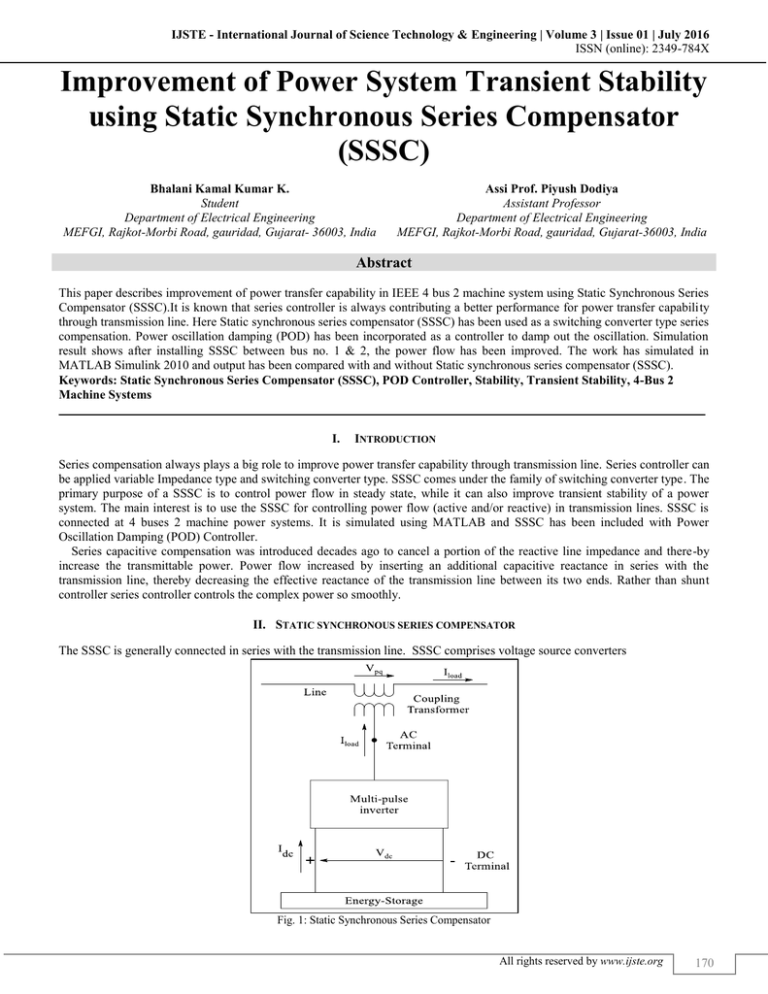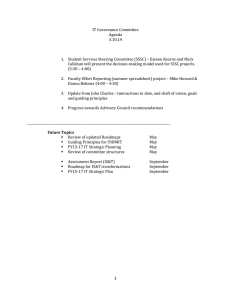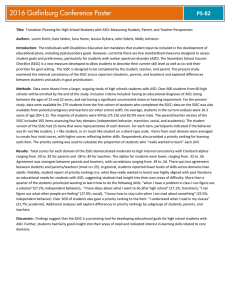
IJSTE - International Journal of Science Technology & Engineering | Volume 3 | Issue 01 | July 2016
ISSN (online): 2349-784X
Improvement of Power System Transient Stability
using Static Synchronous Series Compensator
(SSSC)
Bhalani Kamal Kumar K.
Student
Department of Electrical Engineering
MEFGI, Rajkot-Morbi Road, gauridad, Gujarat- 36003, India
Assi Prof. Piyush Dodiya
Assistant Professor
Department of Electrical Engineering
MEFGI, Rajkot-Morbi Road, gauridad, Gujarat-36003, India
Abstract
This paper describes improvement of power transfer capability in IEEE 4 bus 2 machine system using Static Synchronous Series
Compensator (SSSC).It is known that series controller is always contributing a better performance for power transfer capability
through transmission line. Here Static synchronous series compensator (SSSC) has been used as a switching converter type series
compensation. Power oscillation damping (POD) has been incorporated as a controller to damp out the oscillation. Simulation
result shows after installing SSSC between bus no. 1 & 2, the power flow has been improved. The work has simulated in
MATLAB Simulink 2010 and output has been compared with and without Static synchronous series compensator (SSSC).
Keywords: Static Synchronous Series Compensator (SSSC), POD Controller, Stability, Transient Stability, 4-Bus 2
Machine Systems
_______________________________________________________________________________________________________
I.
INTRODUCTION
Series compensation always plays a big role to improve power transfer capability through transmission line. Series controller can
be applied variable Impedance type and switching converter type. SSSC comes under the family of switching converter type. The
primary purpose of a SSSC is to control power flow in steady state, while it can also improve transient stability of a power
system. The main interest is to use the SSSC for controlling power flow (active and/or reactive) in transmission lines. SSSC is
connected at 4 buses 2 machine power systems. It is simulated using MATLAB and SSSC has been included with Power
Oscillation Damping (POD) Controller.
Series capacitive compensation was introduced decades ago to cancel a portion of the reactive line impedance and there-by
increase the transmittable power. Power flow increased by inserting an additional capacitive reactance in series with the
transmission line, thereby decreasing the effective reactance of the transmission line between its two ends. Rather than shunt
controller series controller controls the complex power so smoothly.
II. STATIC SYNCHRONOUS SERIES COMPENSATOR
The SSSC is generally connected in series with the transmission line. SSSC comprises voltage source converters
Fig. 1: Static Synchronous Series Compensator
All rights reserved by www.ijste.org
170
Improvement of Power System Transient Stability using Static Synchronous Series Compensator (SSSC)
(IJSTE/ Volume 3 / Issue 01 / 030)
And a DC capacitor. The injected voltage of the coupling transformer Vs is perpendicular to the line current. SSSC is used for
controlling active and reactive power in transmission line one side of the converter. It is connected to AC system and other side
is connected to a capacitor and battery. It assumes DC source as battery installation to allow active as well as reactive power
exchanges with the AC system. The voltage with Vpq with respect to the transmission line Iline determines exchange of real and
reactive power with the AC system [1]. The active and reactive power exchange between the SSSC and the transmission line can
be calculated as follows. [9]
Ppq = Vpq . Iline cos φ
Q pq = Vpq . Iline sin φ
Where φ represents the angle between the injected SSSC. The angle between the output voltage of SSSC and line current is
approximately 90.It shows that SSSC real power is small compared to reactive power. The real power going in SSSC is used
only to cover for the losses and charging of the dc capacitor [9]
Ppq= Pdc + Plosses
Basic Operating Principle of The SSSC.
Fig. 2: SSSC phasor diagram
Fig 2. shows that SSSC where DC capacitor exchange by an high energy battery installation to allow active as well as reactive
power exchanges with AC system. Phase displacement of the inserted voltage Vpq with respect to line current determines
exchange of active and reactive power with the AC system. Fig 2. show that line current phasor is used as reference phasor while
max
injected SSSC voltage phasor is rotate around the center of the circle defined by the maximum inserted voltage Vpq
In
capacitive mode, injected SSSC voltage is made to lag the transmission line current by 90 degree.In this case, the SSSC
operation similar to the operation of series capacitor with variable capacitance K*Xc. where K is a variable Vpq= jK*XcIline.[9] Also possible to reverse the injected SSSC voltage by 180, i.e,-V= jK*XcIline. Causing an increase in the
transmission line reactance, which result in decrease of the line current [9]
III. MULTI-MACHINE POWER SYSTEM WITH SSSC
Fig. 2: Multi-Machine Power System with SSSC
All rights reserved by www.ijste.org
171
Improvement of Power System Transient Stability using Static Synchronous Series Compensator (SSSC)
(IJSTE/ Volume 3 / Issue 01 / 030)
The power grid consists of three power generation substations and one major load Centre at bus B1. The first power
generation substation M1 has a rating of 2100 MVA, and the other one M2 has a rating of 1400 MVA, This system which hase
been made in ring mode consisting of 4 buses (B1 to B4) connected to each other through three phase transmission lines L1, L21, L2-2, and L3 with the length of 280,150,150 and 5 km. The phase to phase voltage equal to 13.8 kv.
IV. SSSC POWER OSCILLATION DAMPING CONTROLLER (POD)
Fig. 3: SSSC POD controller
SSSC can be used for damping power oscillation and so enhance the overall dynamic performance of the system.in Fig 3 POD
consists of the three blocks. 1) wash out filter blocks 2) phase compensator block 3) gain block. The washout filter block is used
to avoid a POD response to the steady-state changes of the input signal. Phase compensator block provides the appropriate phase
lag/lead characteristics and stabilizer gain Ks determine the amount of damping introduced by POD.
The selection of an appropriate input signal is a fundamental issue in the design of an effective and robust POD controller.
Locally measurable signals are always preferred as input signal.
Signal such line active power, line reactive power, line current magnitude, bus voltage magnitude and angles are considered in
the selection of input signals for the POD controller in this paper bus voltage and bus current are considered for input signal.
POD design method
A number of design methods may be used for POD parameter tuning. The most popular ones are based on frequency response
[19, 20], eigenvalue sensitivities [21] as well as a combination of these methodologies.
The phase parameters of the phase compensator block are computed as [18]
Where φ the phase to be compensated, ωn is the frequency of the mode to damp and n the number of lead-lag networks
usually 10% damping ratio is considered to be enough. [18]
V. SIMULATION AND RESULT
First power system with two machines and four buses has been simulated in MATLAB environment and then powers and
voltages in all buses have been obtained. The results have been given in Table 1. Using obtained result bus 2 has been selected as
a candidate bus to which the SSSC be installed. Therefore the simulation results have been focused on bus 2
Table – 1
Simulation Result without Sssc
Bus NO V PU I PU P PU Q PU
1
1.00
13.5
20.6
-3.76
2
1.007
6.7
9.95
-1.82
3
1.002
9.8
14.85 -0.48
4
1.015
5.5
8.45
-0.59
All rights reserved by www.ijste.org
172
Improvement of Power System Transient Stability using Static Synchronous Series Compensator (SSSC)
(IJSTE/ Volume 3 / Issue 01 / 030)
Fig. 4: Reactive power of bus-2 without SSSC
1.01
1.009
Voltage Bus2 (pu)
1.008
1.007
1.006
1.005
1.004
0
2
4
6
8
10
12
14
Time
16
18
20
.
Fig. 5: Voltage bus-2 without SSSC
Fig. 6: Active power of bus-2 without SSSC
All rights reserved by www.ijste.org
173
Improvement of Power System Transient Stability using Static Synchronous Series Compensator (SSSC)
(IJSTE/ Volume 3 / Issue 01 / 030)
Change in current, voltage, active and reactive powers of bus-2 have been obtained in real time. The controlling systems in
power plants 1,2 such as governor, PSS and other stabilizing devices are used for damping these oscillations. Oscillations
amplitude for active power is more than reactive power, and this is because the ohmic parts of loads of system are much more.
12.5
12
11.5
Active power (pu)
11
10.5
10
9.5
9
8.5
8
0
1
2
3
4
5
Time
6
7
8
9
10
Fig. 7: Active power of bus-2 with SSSC
-1.2
-1.3
Reactive power (pu)
-1.4
-1.5
-1.6
-1.7
-1.8
-1.9
0
1
2
3
4
5
Time
6
7
8
9
10
Fig. 8: Reactive power of bus-2 with SSSC
1.025
1.02
Voltage bus 2 pu
1.015
1.01
1.005
1
0.995
0.99
0
2
4
6
8
10
12
14
16
18
20
Time
Fig. 5: Voltage bus-2 with SSSC
All rights reserved by www.ijste.org
174
Improvement of Power System Transient Stability using Static Synchronous Series Compensator (SSSC)
(IJSTE/ Volume 3 / Issue 01 / 030)
A
B
C
BUS 1
Pref
Vf
Vf_
Constant
2100 MVA
G1
Reg_M1
Reg_M2
m
L3 - 50 km
A
A
a
A
a
A a
a A
a
A
A
B
B
b
B
b
B b
b B
b
B
B
C
C
c
C
c
C
c C
c
C
C
2100 MVA
13.8 kv /500 kv
c
A
B
C
Pm
BUS 3
L2-2 - 150 km
A
B
C
Pm
BUS 4
L2-1-150 km
Terminator1
A
B
C
Pm
Pm
m
Constant1
Vf_
Vf
Pref
-C-
1400 MVA 1400 MVA
G2
13.8kv / 500 kv
250 MW
Phasors
powergui
100 MW
Bypass
Vqref*
B1
A1
Vqref
C1
C2
Vabc
m
Vabc_B2
100-MVA
SSSC
SSSC
B2
Bypass
50 MW
A2
-C-
m
m
m
Iabc
Iabc_B2
Vqref
P_MW
P_B2
m
POD Controller
Step Vqref
BUS 2
A a
B b
C
c
L1 - 280 km
Fig. 9: Matlab/Simulink Result with SSSC
Fig. 10: Pod controller sub system
All rights reserved by www.ijste.org
175
Improvement of Power System Transient Stability using Static Synchronous Series Compensator (SSSC)
(IJSTE/ Volume 3 / Issue 01 / 030)
Table - 2
Simulation Result without SSSC
Bus NO V PU I PU P PU Q PU
1
1
13.5 19.99 -4.74
2
0.994
7.6
11.26 -1.84
3
1
9.8
14.82 -0.24
4
1
4.6
7.09
-0.24
VI. CONCLUSION
It has been found that the SSSC is capable of controlling the flow of power at a desired point on the transmission line. It is also
observed that the SSSC injects a fast changing voltage in series with the line irrespective of the magnitude and phase of the line
current. Based on obtained simulation results the performance of the SSSC has been examined in a multimachine system, and
applications of the SSSC will be extended in future to a complex system to investigate the problems related to the various modes
of power oscillation in the power system.
REFERENCES
[1]
[2]
[3]
[4]
[5]
[6]
[7]
[8]
[9]
[10]
[11]
[12]
[13]
[14]
[15]
[16]
[17]
[18]
[19]
[20]
[21]
K.K.Sen, “ SSSC static s yn c h r o n ou s s e ri es c om p en s a t o r : theory, modeling, and applications”, IEEE Trans. Power Delv., vol. 13, 241-246, Jan
1998.
P.Kumkratug “Transient Stability Assessment of a power system with a Static Synchronous Series Compensator”, IEEE Trans.
Definition and of Power System Transient Stability IEEE Transactions on Power Systems, vol. 19 No.2, May 2004.
L. Gyugyi, Dynamic compensation of AC transmission line by solid state Synchronous voltage sources, IEEE Trans.
Habibur Rahman, Jewel Rana, Harun-Or-Rashid “Power System Stability Improvement By Using SSSC With Power System Controller” International
Journal of Science, Engineering & Technology Research (IJSETR) Volume 1, Issue 6, December- 2012.
K.R.Padiyar “Facts controllers in power transmission and distribution.”
Mr.G.V. Rajashekar, Dr.Himani Goyal “Power System Enhancement using Static Synchronous Series Compensator” international journal of modern
engineering research (IJMER) vol.3 pp-2530-2536.
Swasti R.Khuntia “Simulation Study of a SSSC-based Neuro-Fuzzy Controller for Improvement of Transient Stability in a Three-Machine Power System”
978-1-4673-1835-8/12/2012 IEEE.
H.Taheri, S.Shahabi, Sh.Taheri, A.Gholami “Application of Synchronous Static Series Compensator (SSSC) on Enhancement of voltage Stability and
Power Oscillation Damping” 978-1-4244-3861-7/09/2009 IEEE.
L.Sunil Kumar, Arindam Ghosh “Static synchronous series compensator design control and application “ELSEVIER.
H.F Wang “Static Synchronous Series Compensator to damp power system oscillations ELSEVIER.
Fawzi A.Rahman AL Jowder “impact of damping scheme on damping characteristic of static synchronous series compensator” 2011 IEEE.
H.M. Ayres, V.F. da Costa “impacts of the sssc control modes on small-signal and transient stability of a power system ELSEVIER.
Dr. Axay J Mehta “Static Synchronous Series Compensator An approach for reactive power compensation for the transmission system” National
Conference on Recent Trends in Engineering & Technology
P. Kundur, “Power System Stability and Control”, McGraw-Hill, 1994.
N. G. Hingorani, and L. Gyugyi, “Understanding FACTS: Concepts and Technology of Flexible AC Transmission Systems”, IEEE Press, New York,
2000.
“K.R.Padiyar “Facts controllers in power transmission and distribution.”
M.S.H.M.Ayres,V.F. da costa, L.C.P.da silva Impacts of the SSSC control modes on small-signal and transient stability of a power system Science direct
N. Martins, L. Lima, Eigenvalue and frequency domain for small-signal electromechanical stability problems, in: IEEE Symposium on Application of
Eigenanalysis and Frequency Domain Methods for System Dynamic Performance Special Publication 90TH0292-3 PWR, 1990, pp. 17–33.
N. Martins, H.J.C.P. Pinto, J.J. Paserba, Using a TCSC for line power scheduling and system oscillation damping – small-signal and transient stability
studies, in: IEEE PES Winter Meeting, vol. 2, 2000, pp. 1455–1461.
L. Rouco, F.L. Pagola, An eigenvalue sensitivity approach to location and controller design of controllable series capacitors for damping power system
oscillations, IEEE Trans. Power Syst. 12 (4) (1997) 1660–1666.
All rights reserved by www.ijste.org
176





